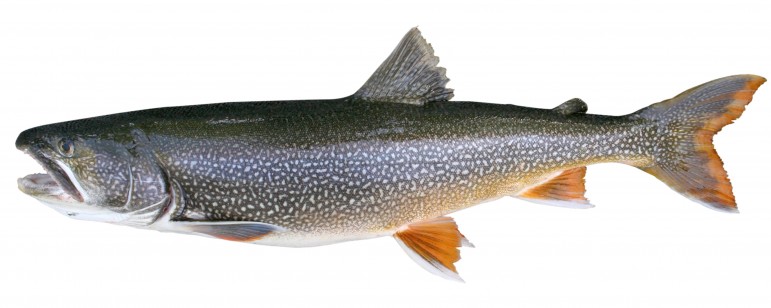
A Thunder Bay National Marine Sanctuary diver deploys fish egg traps on experimental reefs in Lake Huron, just off the Alpena, Mich. shoreline. Image: NOAA, Thunder Bay National Marine Sanctuary.
Maritime archeologists are swapping shipwreck surveys for lake trout mapping in Lake Huron.
And they’re using sound waves to do it.
“Consider it double-dipping. The sonar on research vessels could map an area of interest for shipwrecks while also helping out some biologists,” said Russ Green, program coordinator at Thunder Bay National Marine Sanctuary in Alpena, Mich.
The biologists hope to use the results in lake-wide rehabilitation of trout habitat.
Experts say the Lake Huron trout population is on the rise, but still needs help. This kind of sophisticated mapping of the lake bottom will allow them to better understand their reproductive needs.
Native fish, including lake trout and lake sturgeon, require spawning habitat to shelter their eggs from predators and water currents.
To keep stocks healthy, the U.S. Fish and Wildlife Service contracted with maritime archeologists at the Thunder Bay Sanctuary with a boatload of sensing equipment to scan the lake bottom. That helps them learn more about the habitat — something biologists don’t know much about.
Once they understand what makes this habitat productive, they can start to rehabilitate areas where trout populations are lower.
The effort is a synergy of new surveying technology.
“A natural fit,” said Steve Lenart, fisheries biologist with the Fish and Wildlife Service based in Alpena.
Efforts to restore sustainable fish stocks throughout the Great Lakes began in the 1950s, with Lake Superior showing the greatest success where native lake trout still reproduce in ancestral waters, according to a Great Lakes Fisheries Commission report.
The Fish and Wildlife Service began stocking lake trout in Huron’s Sixth Fathom Bank Sanctuary, a reef formation 40 miles offshore from Alpena in the late 1980s and continued through 1998.
What resulted was a refuge with the “highest area of fish propagation in all of Lake Huron,” said Lenart.
“The concept of establishing an offshore refuge for lake trout was ongoing amongst the management community in the mid 1990s,” he said. “Ultimately the refuge was set aside and a larger contribution of naturally produced fish was seen through the mid-2000s.”
In a refuge like Six Fathom Bank, the taking or fishing of lake trout is prohibited.

Lake trout that spawn at Sixth Fathom Bank are of value to lake-wide research.
Image: Michigan Sea Grant
“The team at Thunder Bay brings the expertise — physical mapping and dive operations — required to realize the genesis of the project, to understand the habitats and lake bottom dynamics at Sixth Fathom Bank,” said Lenart.
That expertise requires a complex multibeam sonar system that shoots sound waves while strapped to the bottom of a research vessel.
It’s similar to side-scan sonar, which acts like an ultrasound, showing visuals as the boat pass over, said Tane Casserley, the sanctuary’s maritime archeologist and dive expert.
“The project pairs an extremely high-resolution multibeam scan of the lake bottom with visuals videotaped from an underwater GoPro,” he said.
The technology, usually reserved for shipwreck imaging in the sanctuary, is now used to match visual and sonar data. This helps biologists determine the material that makes up the lake’s bottom.
“The multibeam sonar acts like a large fish finder, emitting a pulse of sound to measure bathymetry, which is depth. The acoustic data shows contours and gives an idea of lake bottom characteristics,” said Green.
“One piece of the acoustic data describes the intensity of the return — different materials on the bottom will absorb the sound differently,” he said.
Sixth Fathom Bank contains a 60-foot-deep ledge that drops dramatically to the north. The bottom encompasses a uniform layer of limestone, smaller rocks and sand.
This combination of rocky substrate — the type of habitat lake trout prefer for spawning — provides the right characteristics for eggs to be deposited in fall, later hatching in spring.
But biologists don’t have a sense of the amount or distribution of this high-quality reproductive habitat.
The pilot study, which continues next year, contributes to an understanding of the relationship between lake trout population and habitat rehabilitation goals for Lake Huron.
In October, a Sixth Fathom Bank survey reported 60 percent of lake trout were of wild origin — suggesting when conditions are right, such restoration strategies can work.
